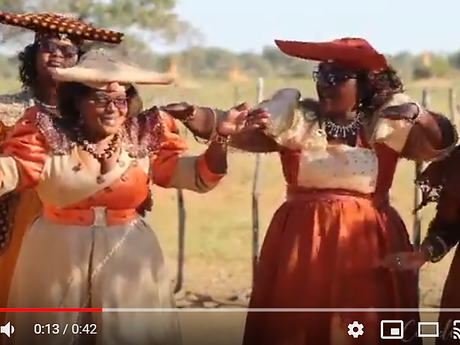“To sing these Herero songs takes a special singer who can get just the right notes. It’s not everybody who can sing the poetry.”
-Jackson Kaujeua, Namibian musician and anti-apartheid activist
Website by Alexandra Charney
Contact: alexandracharney@gfs.org
Traditional Herero Music
“It is an interplay between lead singer and audience which determines the form the song takes. The performance of the song is thus a joint creative event.” -Kirsten Alnaes, author of Living with the Past: The Songs of the Herero in Botswana


Take note of the leader's hand placement from :05-:18. The woman behind her is holding her hands similarly. Using what you have learned about Herero culture (hint: and their headpieces). . .
1. Why do you think they hold their hands like this? If you said it looks like the horns of a cattle, you are probably right. If you said it is the gesture of praise, you may also be right.
2. Why is so hard to know exactly why they move the way they do?
3. If you knew the translation of the lyrics, would you be better prepared to answer the previous question? Why?
4. When deprived of context, how does that lead to the misinterpretations of culture?
5. Is this misinterpretation considered cultural appropriation even if it in unintentional?
6. Why do you think there is a lack of Herero text and song translations online? How does this connect to colonialism and the Herero genocide?
7. How does this lack of representation and acknowledgment affect both the Herero culture itself as well as the study of world music and your own development in this class?
Watch this traditional female dance and song, which is typically sung on Christmas Eve and during weddings, and take note of the form.
Outjina general form:
1. While clapping, leader chants or sings a beginning motif.
2. Leader invites the crowd to "respond" (with a known tune passed on through oral tradition)
3. This singing is mixed with sighs and groans and is very improvisatory.
4. The women interact with each other through movement, which usually involves a small sidestep. The leader may be more expressive in their dancing.
5. A call and response continues between the leader (who is often a professional singer hired for special events) and the crowd.
6. The song ends with a chorus that everyone sings together.
Activity and Followup Questions

Read and reflect on this quote:
"A professional singer will learn his or her craft from older singers who not only pass on the song texts and the motifs with which to adorn and vary them but also teach their apprentices the backgrounds of the songs and their interpretation… Many song texts are obscure, especially the parts which are performed by the singer alone, and may not be generally understood" (Alnaes, 272).
Now, watch one of the videos again, and this time, try to simulate the dance moves you see and the music you hear.
Was this easy or difficult? Did you feel uncomfortable?
How does this music differ from the Western classical canon? How does it make you feel?
Would you be more comfortable having me teach you this music during a class or having a native Herero woman teach? Why? Regardless of your answer to the previous question, which would be a more accurate approach? Which would be more ethical? Why?